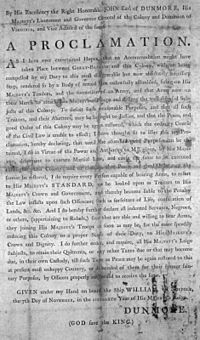Dunmore's Proclamation facts for kids
Quick facts for kids Dunmore's Proclamation |
|
 A copy of the original printing
|
|
| Created | November 7, 1775 |
| Ratified | November 14, 1775 |
| Authors | John Murray, 4th Earl of Dunmore |
| Purpose | To declare martial law, and to encourage slaves of rebels in Virginia to leave their masters and support the Loyalist cause |
Dunmore's Proclamation was an important historical paper signed on November 7, 1775. It was written by John Murray, 4th Earl of Dunmore, who was the British governor of the Colony of Virginia. This proclamation promised freedom to enslaved people who belonged to American revolutionaries. If these enslaved people left their owners and joined the British army, they would become free. They were then known as Black Loyalists.
The proclamation was officially announced on November 15, 1775. After it was made public, between 800 and 2,000 enslaved people ran away. They came from both revolutionary and loyalist owners. Many of them joined Lord Dunmore's forces.
What Was Dunmore's Proclamation?
Dunmore's Proclamation was a special order given by the British governor of Virginia. It was issued during the early days of the American Revolutionary War. The main goal was to get more soldiers for the British side. It also aimed to weaken the American revolutionaries by taking away their enslaved workers.
Why Was It Issued?
Lord Dunmore issued this proclamation for military reasons. He needed more fighters for the British army. He also wanted to cause problems for the American revolutionaries in Virginia. By offering freedom to enslaved people, he hoped to disrupt the revolutionaries' farms and businesses. This was more about winning the war than about helping people for moral reasons.
What Happened Next?
The proclamation made many powerful people in Virginia very angry. These people, both revolutionaries and loyalists, owned enslaved people. They were very afraid of enslaved people rising up against them.
Even with the proclamation, Lord Dunmore's plan did not fully work. He was forced to leave Virginia in 1776. When he left, he took about 300 formerly enslaved people with him.
Later in the war, in 1779, another similar proclamation was made. This was called the Philipsburg Proclamation. It offered freedom to enslaved people in all the colonies, not just Virginia. During the entire Revolutionary War, a large number of enslaved people escaped. Between 80,000 and 100,000 enslaved people ran away from plantations.
Images for kids


